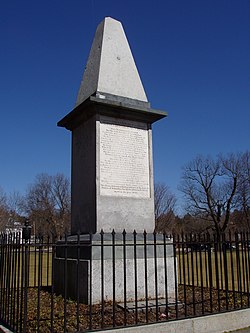Lexington Battle Green
Lexington Green | |
 The Revolutionary Monument 1799 | |
| Location | Massachusetts Avenue and Harrington Road, Lexington, Massachusetts |
|---|---|
| Built | 1711 |
| NRHP reference No. | 66000767[1] |
| Significant dates | |
| Added to NRHP | October 15, 1966 |
| Designated NHL | January 20, 1961 |
The Lexington Battle Green, properly known as Lexington Common, is the historic town common of Lexington, Massachusetts. It was at this site that the opening shots of the Battles of Lexington and Concord were fired on April 19, 1775, starting the American Revolutionary War. Now a public park, the common is a National Historic Landmark.
History
Unlike many other towns, Lexington did not set aside a separate common area when the town was laid out. In 1711, the townspeople raised funds by subscription, and purchased 1.5 acres (0.61 ha) of land as a militia training ground. This was enlarged by one more acre in 1722. The common is a triangular parcel of land, bounded by Massachusetts Avenue, Bedford Street, and Harrington Road, and is located just northwest of Lexington's commercial center. The Buckman Tavern, one of the area's busiest local taverns, stands across Bedford Street; it is also a National Historic Landmark.
In 1775 local militiamen emerged from Buckman Tavern adjacent to the common and formed two rows on the common to face arriving British troops. The militiamen suffered the first casualties of the American Revolution when the two sides exchanged fire.
Description
The battle green, now a public park, is a grassy expanse with a few mature trees. There are several memorials on the fringes of the common, the most iconic being the statue representing Captain John Parker, the leader of the Lexington militia, which stands at its eastern corner. It was erected in 1900 at the bequest of Francis Brown Hayes, and was sculpted by well-known Massachusetts artist Henry Hudson Kitson. A bronze plaque, placed in 1910 by the Daughters of the American Revolution, marks the original location where the Old Belfry stood. This structure is now located up a hill just south of the park. Near the western corner of the park stands what is probably the oldest memorial to the Revolution: it is an obelisk above the grave site of seven of the eight miltiamen killed in the battle, and marks the western end of the Patriot line. The eastern end of the line is marked with an inscribed boulder.[2]
-
The Green in modern times
-
Inscription on the Revolutionary monument
-
Lexington Minutemen relief by Bashka Paeff
-
The Minuteman Statue, 1900
See also
- List of National Historic Landmarks in Massachusetts
- National Register of Historic Places listings in Middlesex County, Massachusetts
- Hancock-Clarke House, another nearby National Historic Landmark
References
- ^ "National Register Information System". National Register of Historic Places. National Park Service. January 23, 2007.
- ^ "NHL nomination for Lexington Green" (PDF). National Park Service. Retrieved April 7, 2014.
External links
- American Revolutionary War sites
- Massachusetts culture
- Massachusetts in the American Revolution
- Lexington, Massachusetts
- National Historic Landmarks in Massachusetts
- National Register of Historic Places in Middlesex County, Massachusetts
- Parks in Middlesex County, Massachusetts
- Visitor attractions in Middlesex County, Massachusetts
- United States history stubs





